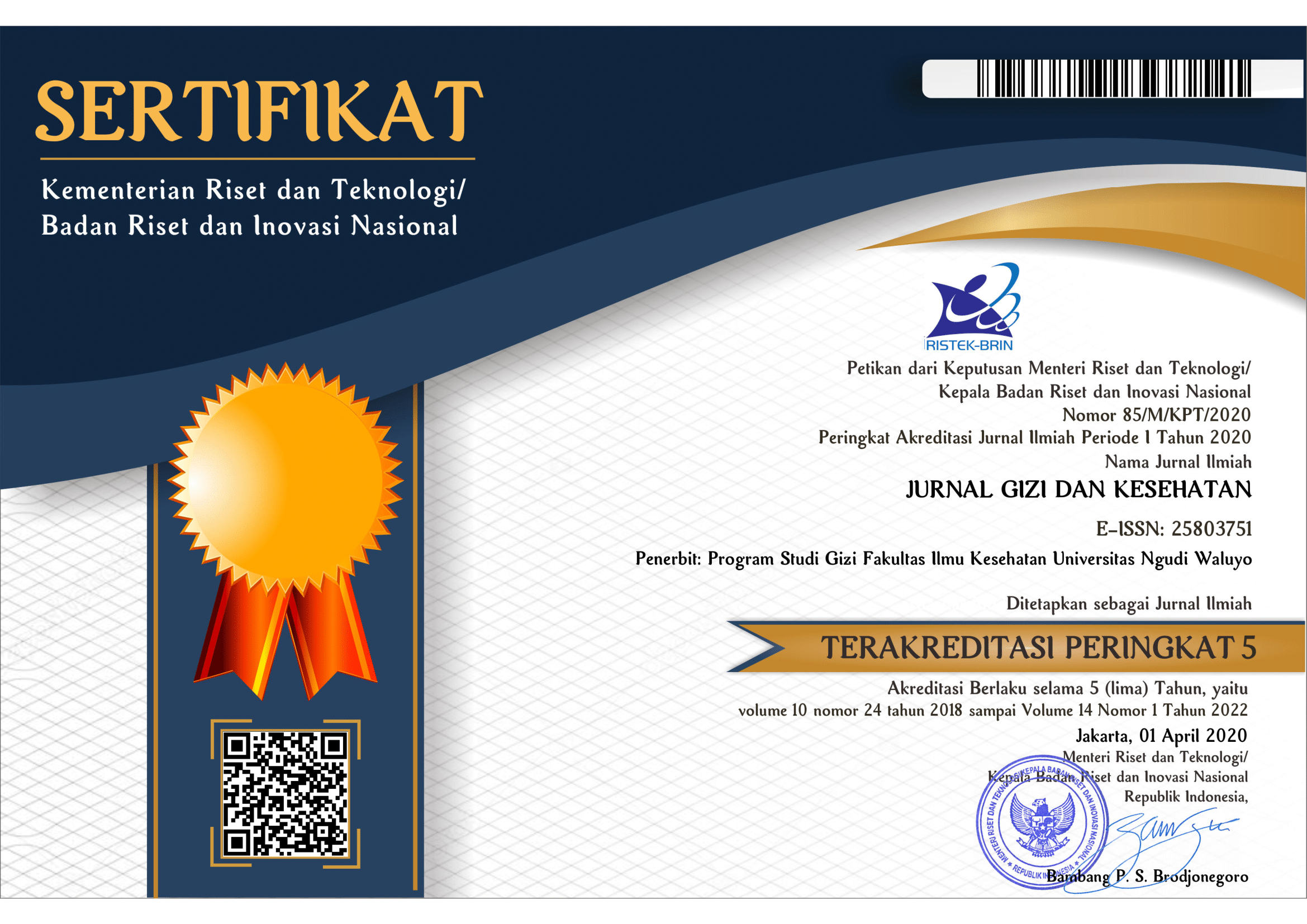Studi Literatur : Diet Kalori Surplus untuk Remaja Underweight
Literature Study: Calorie Surplus Diet for Adolescents With Underweight
Keywords:
Underweight, Remaja, Diet, Kalori SurplusAbstract
Behavioral changes in adolescents can result in dietary changes. Inappropriate diets such as diets that consume energy (calories) in small amounts compared to the daily nutritional needs of adolescents can cause a calorie deficit. A calorie deficit over a long period of time can lead to nutritional status problems, namely being underweight. The purpose of this study was to create a calorie surplus diet and appropriate efforts for adolescents with underweight nutritional problems in Indonesia. This research method uses literature study, collecting data from various online references. From the analysis of the results and discussion it was found that the surplus calorie diet can be provided by consuming food according to individual needs and adding calories between 200-300 kcal / day. Weight gain can occur from muscle mass growth and fat mass gain from a calorie surplus diet. For muscle mass growth, the surplus calorie diet must be balanced with resistance training and protein intake of 2 grams of protein / kg body weight / day. Estimated muscle mass growth of 1 kg in 8 weeks. The conclusion of this study is that a calorie surplus diet is given with the provision of nutritional intake according to needs that are given the right addition of calories for weight gain from muscle mass growth balanced with resistance training to overcome the problem of underweight in adolescents.
ABSTRAK
Perubahan perilaku pada remaja dapat mengakibatkan perubahan diet. Diet yang tidak tepat seperti diet yang mengkonsumsi energi (kalori) dalam jumlah sedikit dibandingkan dengan angka kebutuhan gizi sehari – hari remaja yang dapat menyebabkan terjadinya defisit kalori. Defisit kalori dalam periode waktu yang lama dapat mengakibatkan masalah status gizi, yaitu berat badan kurang (Underweight). Penelitian ini bertujuan untuk menjelaskan diet kalori surplus serta upaya yang tepat ditujukan kepada remaja dengan masalah gizi underweight di Indonesia. Metode penelitian ini menggunakan studi literatur, pengambilan data dari berbagai referensi secara daring. Dari analisis hasil dan pembahasan didapati bahwa diet kalori surplus dapat diberikan dengan konsumsi makanan sesuai kebutuhan individu serta penambahan kalori antara 200 – 300 kkal / hari. Pertambahan berat badan dapat terjadi dari pertumbuhan massa otot dan pertambahan massa lemak dari diet kalori surplus. Untuk pertumbuhan massa otot maka diet kalori surplus harus diimbangi dengan olahraga resistance training serta asupan protein sebesar 2 gram protein / kg berat badan / hari. Estimasi pertumbuhan massa otot sebesar 1 kg dalam 8 minggu. Kesimpulan dari penelitian ini yaitu diet kalori surplus diberikan dengan ketentuan asupan gizi sesuai kebutuhan yang diberi penambahan kalori yang tepat untuk pertambahan berat badan dari pertumbuhan massa otot dengan diimbangi dengan resistance training untuk mengatasi masalah underweight pada remaja.
Downloads
References
Abarca-Gómez, L., Abdeen, Z. A., Hamid, Z. A., Abu-Rmeileh, N. M., Acosta-Cazares, B., Acuin, C., ... & Cho, Y. (2017). Worldwide trends in body-mass index, underweight, overweight, and obesity from 1975 to 2016: a pooled analysis of 2416 population-based measurement studies in 128• 9 million children, adolescents, and adults. The lancet, 390(10113), 2627-2642.
Antonio, J., Ellerbroek, A., Silver, T., Orris, S., Scheiner, M., Gonzalez, A., & Peacock, C. A. (2015). A high protein diet (3.4 g/kg/d) combined with a heavy resistance training program improves body composition in healthy trained men and women–a follow-up investigation. Journal of the International Society of Sports Nutrition, 12(1), 1-9.
Bhutani, S., Wells, N., Finlayson, G., & Schoeller, D. A. (2020). Change in eating pattern as a contributor to energy intake and weight gain during the winter holiday period in obese adults. International journal of obesity, 44(7), 1586-1595.
Dulloo, A. G., Jacquet, J., Miles-Chan, J. L., & Schutz, Y. (2017). Passive and active roles of fat-free mass in the control of energy intake and body composition regulation. European journal of clinical nutrition, 71(3), 353-357.53-7
Eddolls, W. T., McNarry, M. A., Lester, L., Winn, C. O., Stratton, G., & Mackintosh, K. A. (2018). The association between physical activity, fitness and body mass index on mental well-being and quality of life in adolescents. Quality of Life Research, 27(9), 2313-2320.
Garthe, I., Raastad, T., Refsnes, P. E., & Sundgot-Borgen, J. (2013). Effect of nutritional intervention on body composition and performance in elite athletes. European journal of sport science, 13(3), 295-303.
Hall, K. D., Ayuketah, A., Brychta, R., Cai, H., Cassimatis, T., Chen, K. Y., ... & Zhou, M. (2019). Ultra-processed diets cause excess calorie intake and weight gain: an inpatient randomized controlled trial of ad libitum food intake. Cell metabolism, 30(1), 67-77.
Hanum, Y. (2016). Dampak bahaya makanan gorengan bagi jantung. Jurnal Keluarga Sehat Sejahtera, 14(2).
Harries, S. K., Lubans, D. R., Buxton, A., MacDougall, T. H., & Callister, R. (2018). Effects of 12-week resistance training on sprint and jump performances in competitive adolescent rugby union players. The Journal of Strength & Conditioning Research, 32(10), 2762-2769.
Hendra, P., Suhadi, R., Virginia, D. M., & Setiawan, C. H. (2019). Sayur bukan menjadi preferensi makanan remaja di Indonesia. Jurnal Kedokteran Brawijaya, 30(4), 331-335.
Hopkins, M., & Blundell, J. E. (2016). Energy balance, body composition, sedentariness and appetite regulation: pathways to obesity. Clinical Science, 130(18), 1615-1628.
Kemenkes RI. (2017). Tabel Komposisi Pangan Indonesia (TKPI).
Kementrian Kesehatan RI. (2019). Hasil Utama Riset Kesehatan Dasar. Jakarta: Kemenkes RI.
Ochiai, H., Shirasawa, T., Nanri, H., Nishimura, R., Nomoto, S., Hoshino, H., & Kokaze, A. (2017). Lifestyle factors associated with underweight among Japanese adolescents: a cross-sectional study. Archives of Public Health, 75(1), 1-9.
Pengpid, S., & Peltzer, K. (2019). Underweight and overweight or obesity and associated factors among school-going adolescents in five ASEAN countries, 2015. Diabetes & Metabolic Syndrome: Clinical Research & Reviews, 13(6), 3075-3080.
Rawal, T., Willeboordse, M., Arora, M., Sharma, N., Nazar, G. P., Tandon, N., & van Schayck, C. P. (2021). Prevalence of Excessive Weight and Underweight and Its Associated Knowledge and Lifestyle Behaviors among Urban Private School-Going Adolescents in New Delhi. Nutrients, 13(9), 3296.
Romieu, I., Dossus, L., Barquera, S., Blottière, H. M., Franks, P. W., Gunter, M., ... & Willett, W. C. (2017). Energy balance and obesity: what are the main drivers?. Cancer Causes & Control, 28(3), 247-258.
Strope, M. A., Nigh, P., Carter, M. I., Lin, N., Jiang, J., & Hinton, P. S. (2015). Physical activity–associated bone loading during adolescence and young adulthood is positively associated with adult bone mineral density in men. American journal of men's health, 9(6), 442-450.
Zhang, Y., Zeng, Q., Li, X., Zhu, P., & Huang, F. (2018). Application of conicity index adjusted total body fat in young adults-a novel method to assess metabolic diseases risk. Scientific reports, 8(1), 1-7.









